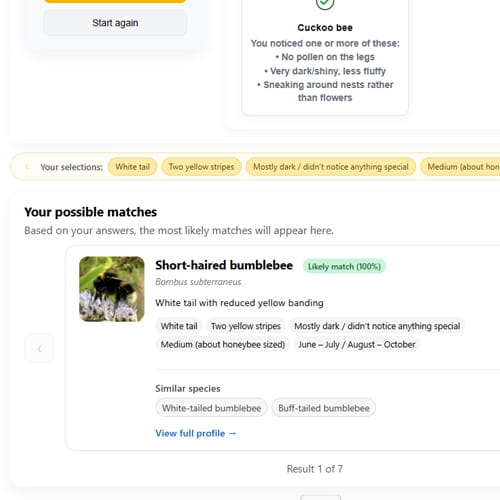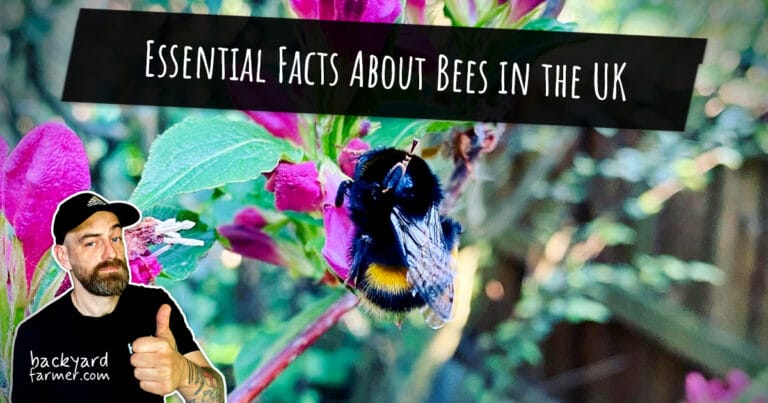Introduction
Bees play a vital role in the UK’s gardens, countryside, and food system. Without them, many of the crops we rely on simply wouldn’t exist. In fact, these bee facts highlight just how important bees are, as they are responsible for pollinating around one in three mouthfuls of food we eat. As a result, their impact reaches almost every meal.
However, bee populations across the UK—and worldwide—are under increasing pressure. Habitat loss, pesticide use, and changing weather patterns are all taking their toll. Because of this, learning a few simple facts about bees is often the first step towards understanding why bees matter and how they support food production and biodiversity.
If you ever spot a bee resting on the ground, don’t panic. Instead, gently move it onto a nearby flower. In some cases, offering a small amount of sugar water on a sponge can help an exhausted bee regain enough energy to fly off again.

Want to know which bee you’re looking at?
Use our UK bee identification hub and interactive tool to identify bee species by size, colour, behaviour, and markings. Visit the Bee Identification Hub to start identifying UK bees.
What Do Bees Do?
There are many types of bees in the UK. Some live in social colonies, while others are solitary. Honeybees are the only species that make honey, but all bees are important pollinators and play a role in supporting healthy ecosystems.
In simple terms, bees:
- Pollinate wildflowers, garden plants, and food crops
- Support healthy ecosystems and biodiversity
- Produce honey (honeybees only)
- Create beeswax and royal jelly
Through pollination, bees help plants reproduce, which in turn supports birds, mammals, and other insects across the UK.
What Do Bees Eat?
Bees feed on two main natural foods:
- Nectar – A sugary liquid that provides energy and is used by honeybees to make honey
- Pollen – A vital source of protein, fats, and nutrients
As bees move from flower to flower collecting nectar and pollen, pollination happens naturally. Over time, this close relationship between flowering plants and bees has evolved to benefit both.
How Do Bees Make Honey?
Only honeybees make honey. They produce it using nectar collected from flowers:
- Nectar is stored inside honeycomb cells
- Warm hive conditions and the fanning of bees’ wings cause moisture to evaporate
- As water content drops, the nectar breaks down into simple sugars
- The thickened substance becomes honey, which is then sealed in the comb
Honey provides a long-lasting food supply for the colony when flowers are scarce.
What Do Bees Use Honey For?
Honey is a stored energy source. Bees rely on it during winter or periods when few flowers are in bloom.
Fresh nectar would naturally ferment, making it useless as stored food. By turning nectar into honey, bees preserve the sugars and create a stable, long-term food supply for the colony.
Where Do Bees Live?
Different bee species live in different types of homes:
- Honeybees – Live in large colonies inside hives
- Bumblebees – Live in smaller colonies, often in old burrows or dense grass
- Solitary bees – Nest alone in soil, hollow plant stems, wood, or walls
In the UK, many bees depend on gardens, hedgerows, wildflower meadows, and undisturbed ground for nesting.
Bee Life & Behaviour Facts
How Long Do Bees Live?
Lifespans vary by species and role. Queen honeybees can live several years, while worker bees often live only a few weeks or months. Solitary bees usually live for one season.
Do Bees Have Knees?
Despite the saying “the bee’s knees”, bees do not have knees. Their legs are made up of six sections connected by flexible joints, without kneecaps.
How Many Wings Does a Bee Have?
Bees have four wings. These give them extra lift, helping them carry pollen and nectar back to the nest.
Do Bees Sleep?
Yes, bees sleep. Honeybees typically rest for five to eight hours a day, and solitary bees can sometimes be seen sleeping inside flowers.
What Happens When a Queen Bee Dies?
If a queen honeybee dies while the colony is active, worker bees select young larvae and feed them royal jelly to raise a new queen.
If more than one new queen develops, they will fight until only one remains. Once a new queen is established, the colony continues as normal.
What Would Happen If Bees Went Extinct?
Without bees, many crops and wild plants would fail to reproduce. This would severely impact food production, wildlife, and ecosystems across the UK.
Replacing bees with human labour or technology would cost billions and still wouldn’t match the efficiency of natural pollination. There is no true replacement for bees. For further information on protecting and supporting bumblebees in the UK, the Bumblebee Conservation Trust offers excellent guidance, research, and practical advice.
To explore this in more depth, see our article on why bees are important.
How Many Types of Bees Are There?
Worldwide, there are around 20,000 known species of bee.
In the UK, we are home to approximately 250 different bee species, including honeybees, bumblebees, and a wide range of solitary bees. Learning to identify them is a great way to understand their roles and protect them.
Bee Facts: FAQs
Bees pollinate many food crops and wild plants in the UK. This supports food production, biodiversity, and healthy ecosystems. Without bees, both farming and wildlife would be seriously affected.
No. Only honeybees make honey. Most UK bees are solitary species that do not produce honey, but all bees help pollinate plants while feeding on nectar and pollen.
Bees eat nectar and pollen. Nectar provides energy, while pollen supplies protein and nutrients. Pollination happens naturally as bees move between flowers.
Yes. Bees do sleep. Honeybees usually rest for five to eight hours, often inside the hive. Solitary bees may sleep inside flowers, especially in cool weather.
No, bees do not have knees. Their legs are made up of six sections connected by flexible joints, but they do not have kneecaps like humans.
Bees have four wings. The two pairs work together during flight, helping bees lift their bodies and carry pollen and nectar.
Bee lifespans vary by species and role. Queen honeybees can live for years, worker bees live weeks or months, and most solitary bees live for one season.
When a queen dies, worker bees raise a new queen by feeding selected larvae royal jelly. If multiple queens emerge, only one survives to lead the colony.
Without bees, many crops and wild plants could not reproduce. Food supplies, ecosystems, and wildlife would be severely affected, and there is no true replacement for bee pollination.
There are around 250 bee species in the UK, including honeybees, bumblebees, and many solitary bees, each with different behaviours and habitats.
Conclusion
Bees are essential to the UK’s environment, food system, and biodiversity. By understanding how bees live, what they need, and why they matter, we can all play a small part in protecting them.
Observing bees in your garden or local green spaces is a great place to start.
Identify the Bees You See
If you’ve spotted a bee and want to know which species it is, our Bee Identification Hub makes it easy to narrow down UK bees using clear traits and visuals.
Explore the Bee Identification Tool to compare species, learn their habits, and understand how each one contributes to pollination.





